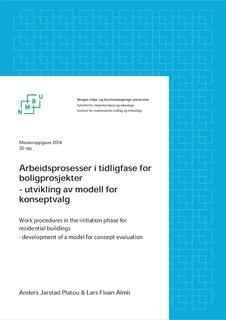| dc.description.abstract | Bygg- og anleggsbransjen arbeider med komplekse utfordringer. Bransjen består av
et stort antall aktører, som sjelden arbeider sammen over lengre tid. Undersøkelser
utført av SINTEF viser at bygg- og anleggsbransjen har store utfordringer knyttet til
byggskader på nye hus i Norge. Kostnadene knyttet til utbedring av
prosessforårsakede byggskader lå i 2007 opp mot 13 milliarder kroner.
Formålet med oppgaven er å utvikle et verktøy som kan brukes til å vurdere og
kvalitetssikre prosessen bak byggtekniske valg som gjøres for boligbygg i prosjektets
tidligfase. Definisjonen av prosjektets tidligfase er når prosjektet kun eksisterer
konseptuelt, før gjennomføringen planlegges i detalj. Tidligfasen starter fra idéen og
behovet er identifisert og avsluttes ved beslutning om at prosjektet skal gjennomføres
eller ikke. Vi har utviklet en modell som kan benyttes ved konseptvalg i
boligprosjekter. Informasjonen i modellen er samlet inn gjennom workshop og
dybdeintervjuer av deltakere med en variert bakgrunn fra REINERTSEN AS. Modellen
er utviklet i Excel.
Ved å benytte konseptvalgsmodellen i tidligfasen i byggeprosjekter kan
konsekvenser, usikkerhetsmomenter og komplikasjoner oppdages.
Konseptvalgsmodellen isolerer ikke valgene til enkeltavgjørelser, men den bidrar til å
se konsekvensene i sammenheng med alle de andre valgene. Ved å bruke
modellen til å analysere et reelt byggeprosjekt har vi vurdert løsningene som ble
valgt i prosjektet mot alternative løsninger. Resultatene våre viser at modellen bidrar
til å formidle erfaringer og kunnskap fra flere parter i byggeprosjekter. Dette er med
på å gi tilbudsgruppa et bedre informasjon- og beslutningsgrunnlag. Mye av
informasjonen i modellen er kvalitative og subjektive vurderinger av usikkerhet og
risiko. Slik sett kan modellen være et nyttig verktøy for å redusere den totale risikoen
ved prosjektet. Modellens omfang er begrenset i oppgaven, så videre arbeider vil
være nødvendig for å utnytte potensialet. For å holde modellen relevant kreves det
at den blir kontinuerlig oppdatert da priser i markedet endrer seg og ny teknologi og
nye løsninger utvikles.
The construction industry is dealing with complex challenges. The industry consists of
a large number of players, who rarely work together for longer timespans. Statistics
conducted by SINTEF shows the construction industry faces significant challenges
related to building damages in new residential constructions. The costs associated
with repairing procedure related building damages was in 2007 nearly 13 billion NOK.
The focus of this thesis is to develop a tool to be used to evaluate and confirm the
quality of the decision process linked with technical solutions made for residential
buildings in the project's initiation phase. Definition of the project's initiation phase is
when the project exists only conceptually, before execution is planned in detail.
Initiation phase starts when the idea and the requirement are identified and ends
with the decision to execute or discard the project. We have developed a model
that can be used for conceptual evaluation in residential building projects. The
information in the model is gathered through workshops and personal interviews of
participants with different backgrounds in REINERTSEN AS. The model is developed in
Excel.
By using the conceptual model in the initiation phase of construction projects,
uncertainties and complications can be detected. The conceptual model does not
isolate the solutions as individual decisions, but it helps to extend the view and see
the consequences in the context of the whole project. Using the model to analyze a
real construction project, we have evaluated the solutions used in the project and
compared to alternative solutions. Our results show that the model helps to convey
the experiences and knowledge from several participants in construction projects.
This helps to give the project group a more sufficient platform for information and
decision making. Much of the information in the model is qualitative and subjective
valuations of uncertainty and risks, thus the model can be a useful tool to reduce the
overall risk of the project. In this thesis the model's scope has been limited, so further
work will be needed to exploit the potential. To keep the model relevant and up to
date requires continually updates as market prices changes and new technologies
and new solutions develops. | nb_NO |
